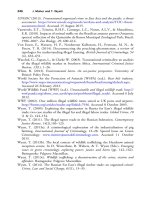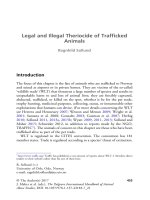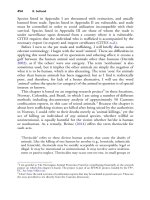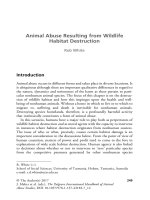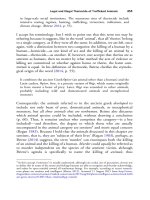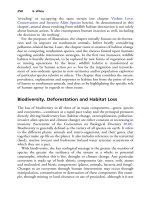The palgrave international handbook of a 452
Bạn đang xem bản rút gọn của tài liệu. Xem và tải ngay bản đầy đủ của tài liệu tại đây (37.63 KB, 1 trang )
454
R. Sollund
Species listed in Appendix I are threatened with extinction, and usually
banned from trade. Species listed in Appendix II are vulnerable, and trade
must be controlled in order to avoid utilization incompatible with their
survival. Species listed in Appendix III are those of whom the trade is
under surveillance upon demand from a country where it is vulnerable.
CITES requires that the individual who is trafficked is accompanied by the
necessary export (re-export) and import certificates (CITES n.d.).
Before I turn to the pet trade and trafficking, I will briefly discuss some
relevant terminology. I begin with the word ‘animal’. There are difficulties in
applying this word because of its speciesism and othering effect; it creates a
gulf between the human animal and animals other than humans (Derridá
2002), as if ‘the others’ were one category. The term ‘nonhuman’ is also
sometimes used, but it implies the other animals are simply the negation of
what it is to be human, which is also alienating. The term ‘aota’ for animals
other than human animals has been suggested, but as I find it stylistically
poor, and therefore, for lack of a better alternative, I will use the word
‘animal’ unless the species (or category) of the animal in question is of special
interest or known.
This chapter is based on an ongoing research project2 in three locations,
Norway, Colombia, and Brazil, in which I am using a number of different
methods including documentary analysis of approximately 50 Customs
confiscation reports, in this case of seized animals.3 Because the chapter is
about how trafficking victims are killed after being seized by the authorities
in Norway, I could refer to their deaths merely as ‘animal killings,’ yet the
act of killing an individual of any animal species, whether willful or
unintentional, is equally harmful for the victim whether he/she is human
or nonhuman. As a remedy, Beirne (2014) offers the term theriocide for
such acts.
‘Theriocide’ refers to those diverse human actions that cause the deaths of
animals. Like the killing of one human by another (e.g., homicide, infanticide
and femicide), theriocide may be socially acceptable or unacceptable, legal or
illegal. It may be intentional or unintentional. It may involve active maltreatment or passive neglect. Theriocides may occur one-on-one, in small groups or
2
I am grateful to The Norwegian Animal Protection Fund for contributing financially to the research
project on which this chapter is based. The project is part of an EFFACE project, funded by the FP7,
EC. See http://efface.eu/.
3
I don’t have the total overview of confiscation reports that may be included in penal cases yet. These are
the ones provided to me directly from the Customs directorate.
